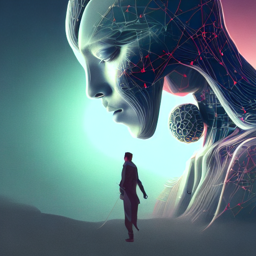Will artificial intelligence bring about the end of homework?

Art courtesy of Dall-E 2. The above image is Dall E’s interpretation of Ai. The program creates artwork based on user input.
February 10, 2023
In recent months, there has been a growing debate on the internet about the use of AI language models for completing homework assignments. The concern is that these models have the ability to generate human-like text, making it easy for students to copy and paste answers to their homework without actually understanding the material. This raises questions about the ethics of using these models for academic purposes and the potential impact on the education system as a whole.
Most argue that the use of AI language models for homework assignments is not only a form of cheating, but diminishes the value of education – it discourages students from actively engaging in learning and encourages them to rely on technology instead.
Or at least, that is what the recently released ChatGPT had to say about the issue. What you just read was written entirely by a computer program developed by OpenAI, one of the leading companies in Artificial Intelligence (AI) technology. In modern times, conversation-AI is capable of generating essay-length responses of understandable, grammatically-correct English in a matter of seconds. Every time a response is generated, the user is asked whether the answer was helpful. Using these responses, the AI learns what works and what does not, allowing it to create more understandable and accurate answers in the future.
Despite an update on Jan. 9 that expanded ChatGPT’s dataset, the most prevalent bottleneck with these engines (other than the servers being constantly overloaded) remains the accuracy of the information. The bot occasionally strays away from the topic, throws together buzzwords or draws information from outdated sources. For this reason, OpenAI has purposefully limited ChatGPT’s knowledge of world events after Sept. 2021, and put a disclaimer stating that the bot “May occasionally produce harmful instructions or biased content.”
While the chatbot is not yet perfect, its writing is certainly fluent enough to compete with or exceed that of the average student – the root of some educators’ concern. Some educational departments are already attempting to install preventative measures against artificial intelligence, but many others see positive potential in this new technology – some teachers go as far as to say that they hope to one day implement it within their classroom.
In an interview with The Wolf, World History teacher Mr. Haley shared his thoughts about a summary written by ChatGPT covering the Japanese annexation of Korea – a topic he was actively teaching at the time of the interview.
Q: How accurate was the information, and how good was the writing?
A: “Other than a preceding event that was left out, everything was relatively and scarily accurate. If a high school student was to write in that style using some of the vocabulary words that were used, I would definitely be suspicious.”
Q: What are your thoughts about this new technology, and the impact it may have on your class?
A: “I look forward to seeing what develops with AI technology in the future and learning how we can incorporate it within our lessons – I think it is another thing to look out for, trying to figure out whether or not students are writing essays with AI. I am not sure what the implications are going to be. We will see how we adapt.”
Q: Do you see this program having a relevant impact on homework/school in the near future, far future, or at all?
A: “Definitely. It is the same kind of thing where math teachers once told us we wouldn’t always have calculators in our pockets – and now we do. Now the question is how we can use this tool to facilitate learning, instead of being afraid of what this new technology is going to bring.”
ChatGPT is not the only creative technology that OpenAI has developed. At the beginning of 2022, OpenAI launched Dall-E, a computer program capable of generating hyper-realistic images of nearly anything the user wants, in the exact art style one prefers. While AI-art apps existed before Dall-E, none were able to generate images as realistic, varied and detailed as it could. Upon release, this leap forward in AI-art technology shook the internet, and has not yet lost its relevance – the website often boasts 3 million users, with 2-4 million unique images being generated every day. In fact, this story’s graphic was created by Dall-E 2, the most recent version of the AI.
So what does this mean for the education system? Similar to calculators and translation websites – technologies that have existed for decades – AI can be beneficial for students without rendering classwork, homework and other creative tasks irrelevant. With the current state of the AI, it would be unrealistic to assume that homework will simply be abandoned in the near future. The most logical solution would be to implement systems that better detect plagiarism, and to support and provide resources for students to take their own creative liberty with school projects.

